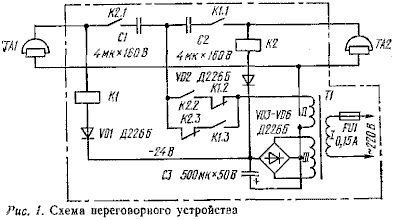Previously described negotiation device [1], which provides telephone communication between two subscribers using a conventional telephone sets. A disadvantage of the device is the need to use the additional buttons for the filing of the challenge.
The call flow in negotiation the device can to automate, if to use the scheme, is depicted in Fig. 1.

When one of subscribers, for example TA1 (TA2), goes off-hook, relay K1 (K2) a voltage is applied. Relay triggered, and through the contacts Kl.1 (K2.1), Kl.3 (K2.2) and normally closed contacts of K2.3 (K1.2) relay K2 (K1) voltage of ~80 In arrives at the call of the apparatus TA2 (TA1). The subscriber TA2 (TA1) picks up the phone. Triggered relay K2 (K1), the contacts of K2.3 (K1.2) open submission call ceases. The Contacts Of K2.1 (Kl.1) closed, is formed the spoken chain. Source the microphone feeding apparatus has no shunt action due to high inductive reactance relay coils K1 and K2 spoken the currents.
The parameters of the transformer T1: core SH. Winding I contains 1320 turns of wire Sew-0-0 2,23. Winding II-500 turns the PEV-0-0 2,12. Winding III-110 of turns of wire sew-0-0 2,35. Used relays Kl, K2 type RES, passport RF4.500.131. Capacitors C1, C2-type MBGO at a working voltage of at least 160 V. the Capacitor NW-oxide K50-6.
Details. Relay Kl-type RES-9, passport RS4.524.200. The thermistor K4-type CMT, CMT. Applied neon lamps TN-0,2-1. Transformer T1-for a voltage of 220 V/27, the secondary winding is designed for a current of 200...300 mA.
Literature
Author: N. The Rodichev; Publication: www.cxem.net






